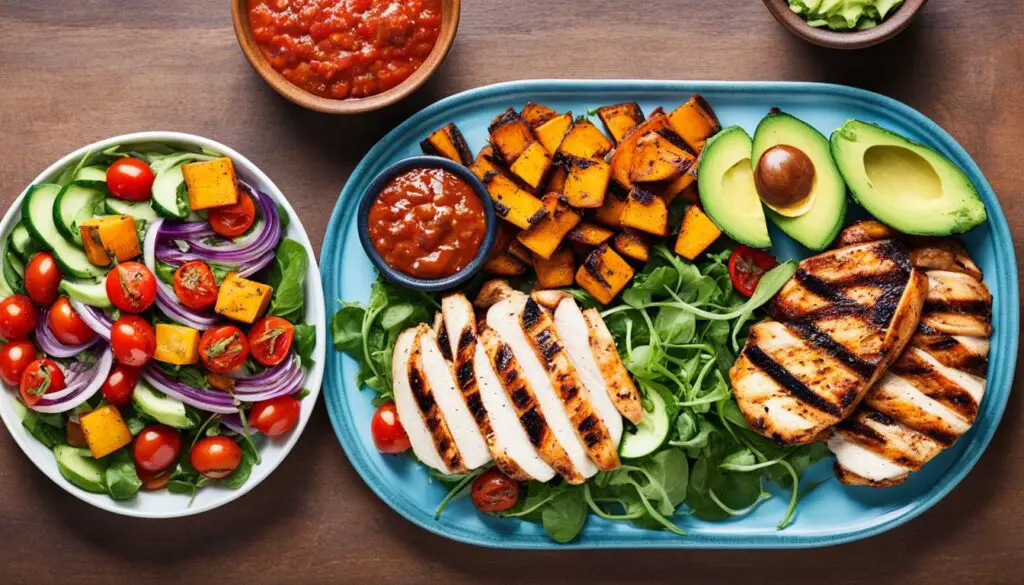I am excited to share with you the benefits of low-glycemic meal plans for weight loss. In today’s world, where many individuals are looking for effective ways to shed excess pounds, low-glycemic meal plans have gained popularity for their ability to provide stable energy levels while promoting sustainable weight loss.
Low-glycemic meal plans prioritize foods with a low glycemic index, which means they have a minimal impact on blood sugar levels. This approach helps prevent the sudden spikes and crashes in energy that can occur with high-glycemic foods. By focusing on whole grains, lean proteins, fruits, and vegetables, low-glycemic meal plans ensure you receive essential nutrients while working towards your weight loss goals.
Key Takeaways:
- Low-glycemic meal plans prioritize foods with a low glycemic index.
- These meal plans provide stable energy levels and prevent energy crashes.
- By focusing on whole grains, lean proteins, fruits, and vegetables, you can achieve sustainable weight loss.
- Low-glycemic meal plans help control cravings and reduce the risk of overeating.
- Incorporating high-fiber foods in these meal plans aids in appetite control.
Benefits of Low-Glycemic Meal Plans for Weight Loss
Low-glycemic meal plans have numerous benefits when it comes to weight loss. These meal plans are designed to stabilize blood sugar levels, which in turn helps control cravings and reduce the risk of overeating. By including high-fiber foods, such as whole grains, fruits, and vegetables, low-glycemic meal plans keep you feeling full for longer, promoting better appetite control.
One of the key advantages of low-glycemic meal plans is their ability to improve insulin sensitivity. When insulin sensitivity is improved, the body can more effectively regulate blood sugar levels and metabolize carbohydrates. This can contribute to weight loss by reducing the likelihood of excess glucose being stored as fat.
Moreover, low-glycemic meal plans can support heart health. By prioritizing whole foods and limiting processed sugars and refined grains, these plans can help lower the risk of cardiovascular disease and associated conditions.
| Benefits of Low-Glycemic Meal Plans for Weight Loss |
|---|
| Stabilize blood sugar levels |
| Control cravings and reduce overeating |
| Aid in appetite control by promoting fullness |
| Improve insulin sensitivity |
| Promote utilization of stored fat for energy |
| Support heart health |
By following a low-glycemic meal plan, individuals can achieve their weight loss goals while maintaining energy levels and overall well-being. The balanced approach to nutrition provided by these meal plans ensures that essential nutrients are obtained while excess calories are minimized. So, if you’re looking for an effective and sustainable way to lose weight, incorporating low-glycemic meal plans into your routine could be the answer.
Focusing on nutrient density
Low-glycemic meal plans prioritize nutrient-dense foods that provide essential vitamins, minerals, and antioxidants. By focusing on whole grains, lean proteins, fruits, and vegetables, these meal plans ensure that individuals receive the necessary nutrients for optimal health, while also aiding in weight loss. It’s all about nourishing your body with the right foods, promoting lasting results.
“Low-glycemic meal plans are a game-changer for weight loss. They not only stabilize blood sugar levels but also improve insulin sensitivity and support cardiovascular health. By following a low-glycemic meal plan, individuals can achieve their weight loss goals while feeling satisfied and energized.” – Erica Johnson, Registered Dietitian
Tips for Following a Low-Glycemic Meal Plan
Following a low-glycemic meal plan can be easier with a few tips. Incorporating a variety of low-glycemic foods into your diet is key. These include whole grains, lean proteins, fruits, and vegetables. By choosing these nutrient-rich options, you can help stabilize your blood sugar levels and maintain sustained energy throughout the day.
Avoiding processed and sugary foods is essential when following a low-glycemic meal plan. These types of foods can cause spikes in blood sugar, leading to energy crashes and cravings. By focusing on whole foods and minimizing your intake of processed and sugary options, you can better manage your blood sugar levels and achieve your weight loss goals.
Planning your meals in advance can also greatly contribute to your success on a low-glycemic meal plan. By taking the time to plan, you can ensure that your meals are well-balanced and nutritious. It’s helpful to create a weekly menu and prepare your meals in advance, so you have healthy options readily available. This can prevent you from reaching for unhealthy choices when you’re pressed for time or feeling hungry.
Tracking your food intake and monitoring portion sizes can provide valuable insights and help you make informed decisions about your meals. By keeping a food journal or using a tracking app, you can gain a better understanding of your eating habits and make adjustments as needed. Additionally, paying attention to portion sizes can help you maintain a calorie deficit and support your weight loss journey.
Staying hydrated and engaging in regular physical activity are also important aspects of following a low-glycemic meal plan. Drinking an adequate amount of water can help regulate blood sugar levels and prevent dehydration. Physical activity, such as cardiovascular exercises and strength training, can further enhance your weight loss efforts by increasing calorie burn and improving overall fitness.
Summary of Tips for Following a Low-Glycemic Meal Plan:
- Incorporate a variety of low-glycemic foods into your diet.
- Avoid processed and sugary foods that can cause blood sugar spikes.
- Plan your meals in advance to ensure a balanced and nutritious menu.
- Track your food intake and monitor portion sizes.
- Stay hydrated and engage in regular physical activity.
Following these tips can empower you to successfully navigate a low-glycemic meal plan. By adopting healthy eating habits and making mindful choices, you can achieve your weight loss goals while maintaining stable energy levels. Remember, consistency and a balanced approach to nutrition are key factors in sustaining long-term success.
Sample Low-Glycemic Meal Plan for Weight Loss
Looking for a sample low-glycemic meal plan to help you on your weight loss journey? Below is an example of a delicious and satisfying meal plan that focuses on whole, unprocessed foods with a low glycemic index. By following this meal plan, you can achieve your weight loss goals while enjoying nutritious meals.
| Meal | Food Choices |
|---|---|
| Breakfast | Oatmeal with berries and nuts |
| Lunch | Salad with grilled chicken and mixed vegetables |
| Dinner | Baked salmon with quinoa and roasted vegetables |
| Snacks |
|
The key to this low-glycemic meal plan is to choose whole, unprocessed foods that have a low glycemic index. These foods provide a balance of nutrients while helping to stabilize blood sugar levels and prevent energy crashes.
This meal plan offers a variety of options to keep your taste buds satisfied and your body fueled with stable energy. From the delicious combination of oatmeal, berries, and nuts in the morning to the savory flavors of grilled chicken and roasted vegetables for lunch and dinner, this meal plan proves that healthy eating can be both enjoyable and effective for weight loss.
By following a low-glycemic meal plan like this, you can take control of your weight loss journey without sacrificing taste or nutrition. Remember to listen to your body, stay hydrated, and engage in regular physical activity to support your overall well-being.
Conclusion
Low-glycemic meal plans are a proven and sustainable way to achieve weight loss while maintaining stable energy levels. By focusing on foods with a low glycemic index, these meal plans help stabilize blood sugar levels, preventing energy crashes and promoting a healthy and balanced diet.
Incorporating a variety of whole grains, lean proteins, fruits, and vegetables ensures that individuals receive essential nutrients while on their weight loss journey. These nutrient-dense foods not only support weight loss but also provide long-lasting energy to fuel daily activities.
Furthermore, low-glycemic meal plans offer additional benefits such as improved insulin sensitivity and potential heart health advantages. By choosing low-glycemic options, individuals can manage their weight more effectively and enjoy overall well-being.
For individuals looking to achieve and maintain a healthy weight, low-glycemic meal plans provide a holistic approach that combines effective weight loss strategies with sustainable energy levels. By making smart food choices, individuals can embark on a journey to transform their bodies and lives.
FAQ
What are low-glycemic meal plans?
Low-glycemic meal plans prioritize foods with a low glycemic index, which means they have a minimal impact on blood sugar levels. These meal plans help prevent energy crashes and stabilize blood sugar levels.
What are the benefits of low-glycemic meal plans for weight loss?
Low-glycemic meal plans offer several benefits for weight loss. They help control cravings, reduce the risk of overeating, keep you feeling full for longer, improve insulin sensitivity, burn stored fat for energy, and support heart health.
How can I follow a low-glycemic meal plan?
To follow a low-glycemic meal plan, incorporate a variety of low-glycemic foods into your diet, avoid processed and sugary foods, plan your meals in advance, track your food intake and portion sizes, stay hydrated, and engage in regular physical activity.
Can you provide a sample low-glycemic meal plan for weight loss?
Sure! A sample low-glycemic meal plan for weight loss might include options like oatmeal with berries and nuts for breakfast, a salad with grilled chicken and mixed vegetables for lunch, and baked salmon with quinoa and roasted vegetables for dinner. Snacks can include Greek yogurt, carrot sticks with hummus, or a handful of almonds.
Source Links
- https://probusinessandtaxservice.com/web-stories/the-7-best-weight-loss-meal-plans-for-women/
- https://barca10.reinboldssales.com/web-stories/living-a-low-carb-lifestyle/
- https://www.mediebook.com/kecveto-transform-your-life-with-this-revolutionary-lifestyle/



